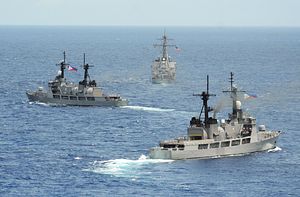This week, Philippine Defense Secretary Delfin Lorenzana was in South Korea for a bilateral visit. Lorenzana’s trip once again put the spotlight on the defense collaboration underway between the two countries.
As I have noted before in these pages, South Korea has been a key partner for the Philippines as it attempts to boost its limited defense capabilities. Though the defense relationship has been growing in other areas too, the aspect that receives the most public attention is the defense deals that Seoul has been involved in, be it the transfer of 12 FA-50 fighter jets to Manila by state-owned Korea Aerospace Industries or the sale of two frigates from Hyundai Heavy Industries, which had been one of the biggest line items in Philippine military modernization.
Though the frigate sale has been the product of the growing defense ties between Seoul and Manila, at home in the Philippines, it has been subject to controversy as I have observed before (See: “Frigate Controversy Puts Philippine Military Modernization in the Spotlight”). This was just one example of the broader challenges that remain for Philippine military modernization that can delay or complicate the acquisition of assets it urgently needs, which have been illustrated in other recent cases as well (See: “What a Dead Philippines-Canada Helicopter Deal Would Mean”).
Lorenzana was in South Korea for a series of engagements that reportedly included meetings with counterparts and attending the steel-cutting ceremony for two frigates that the Philippines has ordered from South Korea.
Few details were released on the specifics related to the ceremony or progress with respect to the frigate program. But the move towards construction as evidenced by the steel-cutting ceremony Lorenzana was scheduled to attend is consistent with previous suggestions that the administration of President Rodrigo Duterte intends to make sure that the frigate deal between the two countries proceeds as scheduled.
South Korea’s defense ministry said that Lorenzana’s meeting with his South Korean counterpart Song Young-moo also saw the two countries touch on other bilateral and regional defense issues. Bilaterally, both sides pledged to continue their collaboration on defense equipment and other related areas, a general articulation that avoided the specifics that might have stoked further controversy.
Unsurprisingly, the regional focus was on North Korea. Song briefed Lorenzana on the outcome of the inter-Korean summit talks last week and called for Manila’s support to achieve the denuclearization of the Korean peninsula. As I have noted before, the Philippines is among several Southeast Asian countries that South Korea has been trying to cultivate as it builds out its approach to North Korea but also to the region more broadly (See: “Why was a North Korean Official in the Philippines Ahead of an ASEAN Meeting?”).

































